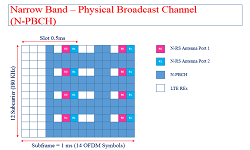5G NR QoS characteristics
5G QoS characteristics describe the packet forwarding treatment that a QoS Flow receives edge-to-edge between the UE and the UPF in terms of the following performance characteristics:
- Resource Type (GBR, Delay critical GBR or Non-GBR)
- Priority Level
- Packet Delay Budget
- Packet Error Rate
- Averaging window (for GBR and Delay-critical GBR resource type only)
- Maximum Data Burst Volume (for Delay-critical GBR resource type only)
The 5G QoS characteristics should be understood as guidelines for setting node specific parameters for each QoS Flow e.g. for 3GPP radio access link layer protocol configurations. Standardized or pre-configured 5G QoS characteristics, are indicated through the 5QI value, and are not signalled on any interface, unless certain 5G QoS characteristics are modified.
Resource Type
The Resource Type determines if dedicated network resources related to a QoS Flow-level Guaranteed Flow Bit Rate (GFBR) value are permanently allocated (e.g. by an admission control function in a radio base station). There are following resource types
- GBR
- Non-GBR
- Delay-critical GBR
GBR QoS Flows are typically authorized “on demand” which requires dynamic policy and charging control. A GBR QoS Flow uses either the GBR resource type or the Delay-critical GBR resource type. The definition of PDB and PER are different for GBR and Delay-critical GBR resource types and Maximum Data Burst Volume (MDBV) parameter applies only to the Delay-critical GBR resource type. A Non-GBR QoS Flow may be pre-authorized through static policy and charging control. A Non-GBR QoS Flow uses only the Non-GBR resource type
Priority Level
The Priority Level associated with 5G QoS characteristics indicates a priority in scheduling resources among QoS Flows and it has following characteristics:
- The lowest Priority Level value corresponds to the highest priority.
- The Priority Level shall be used to differentiate between QoS Flows of the same UE, and it shall also be used to differentiate between QoS Flows from different UEs.
- In congestion case, when all QoS requirements cannot be fulfilled for one or more QoS Flows, the Priority Level shall be used to select for which QoS Flows the QoS requirements are prioritised such that a QoS Flow with Priority Level value N is priorized over QoS Flows with higher Priority Level values (i.e. N+1, N+2, etc).
- In non-congestion case, the Priority Level should be used to define the resource distribution between QoS Flows. In addition, the scheduler may prioritize QoS Flows based on other parameters (e.g. resource type, radio condition) in order to optimize application performance and network capacity.
- Every standardized 5QI is associated with a default value for the Priority Level -specified in QoS characteristics
- Priority Level may also be signalled together with a standardized 5QI to the -R)AN, and if it is received, it shall be used instead of the default value.
- Priority Level may also be signalled together with a pre-configured 5QI to the (R)AN, and if it is received, it shall be used instead of the pre-configured value.
Packet Delay Budget
The Packet Delay Budget (PDB) defines an upper bound for the time that a packet may be delayed between the UE and the UPF that terminates the N6 interface. PDB has following characteristics:
- For a certain 5QI the value of the PDB is the same in UL and DL.
- In the case of 3GPP access, the PDB is used to support the configuration of scheduling and link layer functions (e.g. the setting of scheduling priority weights and HARQ target operating points).
- For GBR QoS Flows using the Delay-critical resource type, a packet delayed more than PDB is counted as lost if the data burst is not exceeding the MDBV within the period of PDB and the QoS Flow is not exceeding the GFBR.
- For GBR QoS Flows with GBR resource type not exceeding GFBR, 98 percent of the packets shall not experience a delay exceeding the 5QI’s PDB.
- Services using a GBR QoS Flow and sending at a rate smaller than or equal to the GFBR can in general assume that congestion related packet drops will not occur.
- Services using Non-GBR QoS Flows should be prepared to experience congestion-related packet drops and delays. In uncongested scenarios, 98 percent of the packets should not experience a delay exceeding the 5QI’s PDB
- PDB for Non-GBR and GBR resource types denotes a “soft upper bound” in the sense that an “expired” packet, e.g. a link layer SDU that has exceeded the PDB, does not need to be discarded and is not added to the PER.
- PDB for a Delay critical GBR resource type, packets delayed more than the PDB are added to the PER and can be discarded or delivered depending on local decision.
Packet Error Rate
The Packet Error Rate (PER) defines an upper bound for the rate of PDUs (e.g. IP packets) that have been processed by the sender of a link layer protocol e.g. RLC, but that are not successfully delivered by the corresponding receiver to the upper layer e.g. PDCP in RAN.
- The PER defines an upper bound for a rate of non-congestion related packet losses.
- The purpose of the PER is to allow for appropriate link layer protocol configurations (e.g. RLC and HARQ in RAN of a 3GPP access).
- For every 5QI the value of the PER is the same in UL and DL.
- For GBR QoS Flows with Delay critical GBR resource type, a packet which is delayed more than PDB is counted as lost, and included in the PER unless the data burst is exceeding the MDBV within the period of PDB or the QoS Flow is exceeding the GFBR.
Averaging Window
The Averaging window represents the duration over which the GFBR and MFBR shall be calculated e.g. in the RAN, UPF, UE.
- Each GBR QoS Flow shall be associated with an Averaging window.
- Every standardized 5QI (of GBR and Delay-critical GBR resource type) is associated with a default value for the Averaging window
- The averaging window may also be signalled together with a standardized 5QI to the RAN and UPF, and if it is received, it shall be used instead of the default value.
- The Averaging window may also be signalled together with a pre-configured 5QI to the RAN, and if it is received, it shall be used instead of the pre-configured value.
Maximum Data Burst Volume
Maximum Data Burst Volume denotes the largest amount of data that the 5G-AN is required to serve within a period of 5G-AN PDB (i.e. 5G-AN part of the PDB)
- Each GBR QoS Flow with Delay-critical resource type shall be associated with a Maximum Data Burst Volume
- Every standardized 5QI of Delay-critical GBR resource type is associated with a default value for the MDBV
- MDBV may also be signalled together with a standardized 5QI to the (R)AN, and if it is received, it shall be used instead of the default value. The MDBV may also be signalled together with a pre-configured 5QI to the (R)AN, and if it is received, it shall be used instead of the pre-configured value.
Reference:
- 3GPP TS 23.501; System architecture for the 5G System (5GS)
Related Post:
- NR-Logical Channels,Transport Channels and Physical Channels Mapping
- NR Radio Network Temporary Identifier (RNTI)
- 5G New Radio Throughput Capabilities
- 5G New Radio Spectral Efficiency
- 5G NR Control Plane Latency



